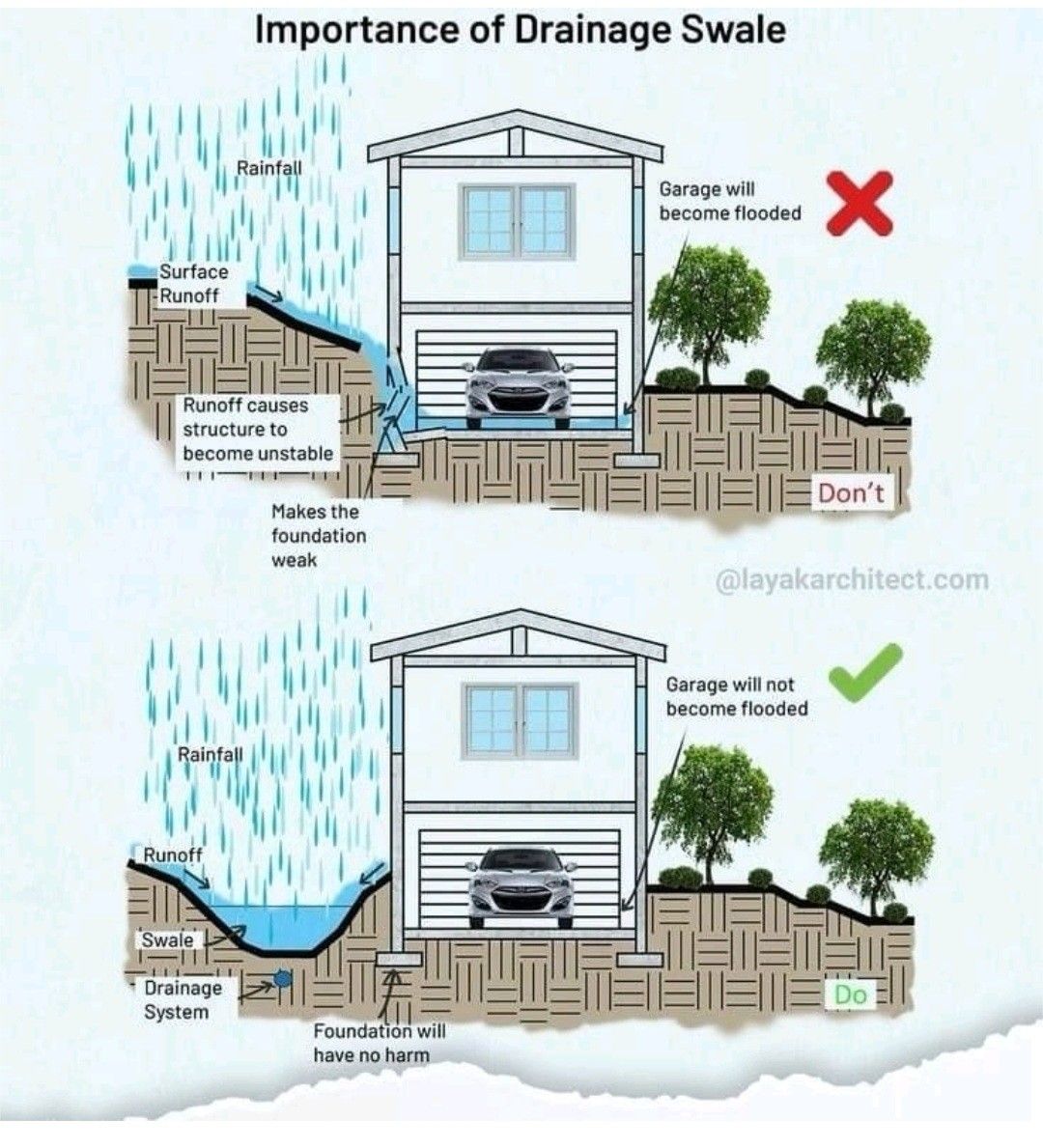A simple landscape feature can save garages, foundations, and entire homes from rainwater damage—why every homeowner should care about drainage swales.
Every rainy season, thousands of homeowners face a recurring nightmare: flooded garages, waterlogged basements, and cracked foundations. While heavy rainfall is often blamed, the real culprit usually lies in poor water management around buildings. One of the simplest, most effective, and often overlooked solutions is the drainage swale.
Swales, shallow channels designed to guide rainwater away from structures, may not look glamorous, but they are essential to sustainable architecture and urban planning. By redirecting runoff, swales protect homes, strengthen foundations, and prevent costly water damage.
The illustration above perfectly demonstrates the difference between a property with and without a drainage swale. The outcome is striking: one home stays safe and dry, while the other faces structural risks and flooding.
🌧️ What is a Drainage Swale?
A drainage swale is a shallow, sloped channel, often grass-lined or landscaped, that collects and directs rainwater runoff away from vulnerable areas such as:
- House foundations
- Driveways and garages
- Gardens and yards
Unlike storm drains or pipes, swales are designed to slow down water, allowing it to soak into the ground while still protecting structures. This not only prevents flooding but also recharges groundwater and reduces pressure on municipal drainage systems.
🚫 The “Don’t” Scenario: When Swales Are Ignored
The top half of the diagram shows what happens when a home lacks a proper swale:
- Surface Runoff Hits Directly
Rainwater flows unchecked toward the garage. With no swale to catch and redirect it, the water finds the easiest path—into the structure itself. - Foundation Weakening
Constant waterlogging erodes soil around the foundation, making it unstable. Over time, cracks develop, and the building’s strength is compromised. - Garage Flooding
The low-lying garage becomes a collection basin. Cars, storage, and flooring are at risk, costing homeowners thousands in damages.
This is a classic case of a small design oversight turning into a big financial burden.
✅ The “Do” Scenario: When Swales Save the Day
Now compare that with the bottom half of the diagram, where a swale has been implemented:
- Rainwater Collection
Instead of rushing toward the house, rainfall runoff collects in the swale. - Safe Diversion
The swale channels water into a drainage system, ensuring it flows away from the foundation and garage. - No Structural Damage
The soil around the house remains stable, the garage stays dry, and the foundation suffers no harm.
The difference is night and day—proof that even a shallow channel of earth and plants can provide huge protection.
🏗️ Why Drainage Swales Matter in Modern Housing
1. Climate Change and Extreme Rainfall
With rising global temperatures, extreme weather events like heavy downpours are becoming more frequent. Homes not designed with proper drainage are at greater risk of flooding. Swales are an inexpensive and eco-friendly buffer against climate change.
2. Foundation Protection
Repairing a cracked or weakened foundation can cost anywhere from $5,000 to $30,000 depending on severity. Installing a swale, by contrast, is a fraction of that cost and acts as a preventive measure.
3. Environmental Benefits
Swales filter out sediments and pollutants from runoff, improving groundwater quality. Many modern swales are designed with vegetation that enhances biodiversity while still controlling water flow.
4. Urban Resilience
In cities, paved surfaces prevent rain from soaking into the ground, leading to flash floods. Swales are a nature-based solution, blending landscaping with infrastructure to make urban areas more resilient.
🌱 The Anatomy of a Good Swale
A well-designed swale includes:
- Gentle Slopes: To slow down water, not accelerate it.
- Vegetation: Grass, shrubs, or even wildflowers help absorb water and filter pollutants.
- Drainage Outlets: Ensuring water is guided toward storm drains, retention ponds, or natural streams.
- Permeable Materials: Gravel or soil that allows infiltration, reducing surface runoff.
By combining these elements, swales provide both functionality and aesthetic appeal. In fact, many landscape architects now design swales that double as decorative garden features.
🏘️ Real-Life Applications
- Residential Homes
Many homeowners in flood-prone areas now add swales along driveways and near garages to prevent waterlogging. - Commercial Developments
Shopping malls and office complexes use swales in parking lots to handle massive amounts of runoff. - Public Spaces
Parks and greenways often integrate swales, turning them into eco-friendly drainage systems that also enhance greenery.
💡 Expert Tips for Homeowners
- Always slope the ground away from the house, not toward it.
- Maintain swales by removing debris and replanting vegetation as needed.
- Pair swales with rain gardens or permeable paving for maximum water management.
- If building a new home, insist your architect or builder incorporates swale systems into the site plan.
📊 Cost vs. Benefit
- Cost of Installing a Swale: $500–$3,000 (depending on size and complexity).
- Cost of Flood Damage Repair: $10,000+ per incident.
- Cost of Foundation Repair: $5,000–$30,000.
It’s easy to see why swales are a wise investment.
🌍 Conclusion
The importance of drainage swales cannot be overstated. They are small, affordable features that protect homes from flooding, preserve structural integrity, and contribute to a healthier environment.
In an era of rising construction costs and worsening climate impacts, homeowners and city planners alike must pay attention to this simple yet powerful solution.
So the next time rain pours down, ask yourself: is your house equipped with a swale? If not, it might be time to dig one—before nature does it for you.
